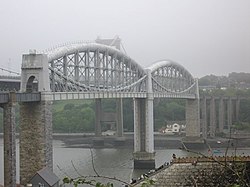| Cornwall Railway | |
|---|---|
 The Royal Albert Bridge that carries the route of the Cornwall Railway across the River Tamar | |
| History | |
| 1835 | Proposal for a railway from London to Falmouth |
| 1839 | Proposal for the Cornwall Railway |
| 1846 | Cornwall Railway Act |
| 1848–52 | Construction suspended |
| 1859 | Opened from Plymouth to Truro |
| 1863 | Opened Truro to Falmouth |
| 1867 | Branch opened to Keyham Dockyard |
| 1876 | Cornwall Loop line opened in Plymouth |
| 1889 | Line sold to the Great Western Railway |
| Engineering | |
| Engineer | Isambard Kingdom Brunel |
| Gauge | 7 ft 1⁄4 in (2,140 mm) Brunel gauge converted to 4 ft 8+1⁄2 in (1,435 mm) standard gauge in 1892 |
| Successor organisation | |
| 1889 | Great Western Railway |
| 1948 | British Railways |
| Key locations | |
| Headquarters | Truro, Cornwall |
| Workshops | Lostwithiel |
| Major stations | St Austell Truro Falmouth |
| Key structures | Royal Albert Bridge and numerous timber trestle viaducts |
| Route mileage | |
| 1859 | 53.50 miles (86.10 km) |
| 1863 | 65.34 miles (105.15 km) |
The Cornwall Railway was a 7 ft 1⁄4 in (2,140 mm) broad gauge railway from Plymouth in Devon to Falmouth in Cornwall, England, built in the second half of the nineteenth century. It was constantly beset with shortage of capital for the construction, and was eventually forced to sell its line to the dominant Great Western Railway.
The Cornwall Railway was famous for building the majestic Royal Albert Bridge over the River Tamar and, because of the difficult terrain it traversed, it had a large number of viaducts, built as timber trestles because of the shortage of money. They proved to be iconic structures, but were a source of heavy maintenance costs, eventually needing to be reconstructed in more durable materials.
Its main line was the key route to many of the holiday destinations of Cornwall, and in the first half of the 20th century it carried holidaymakers in summer, as well as vegetables, fish and cut flowers from Cornwall to markets in London and elsewhere in England. The section from Truro to Falmouth, originally part of its main line, never fulfilled its potential and soon became a branch line. Nonetheless the entire route (with some minor modifications) remains open, forming part of the Cornish Main Line from Plymouth to Penzance. The Truro to Falmouth branch continues: the passenger service on it is branded the Maritime Line.
© MMXXIII Rich X Search. We shall prevail. All rights reserved. Rich X Search
